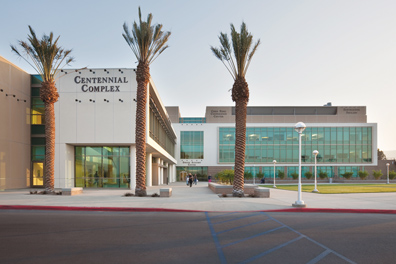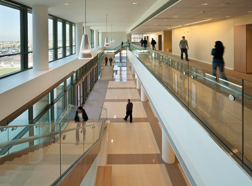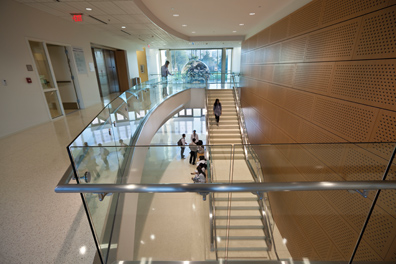Facility of the Month: Loma Linda University

It had been 20 years since Loma Linda University had seen a new academic facility on the campus. After funding for a recreation center and a cancer research center was complete, the time finally came to build the school’s Centennial Complex, completed in August 2009.
The 149,000-square-foot, four-level building includes classrooms, labs, exam rooms, faculty offices and an Amphitheater Center with 250-seat and 350-seat theaters for regularly scheduled classes, seminars and programs.
Located at the Loma Linda University Adventist Health Sciences Center in Southern California, a private school founded in 1905, the complex and utilities tunnel were constructed within an $86 million project budget by Newport Beach, Calif.-based McCarthy Building Cos.
A growing student population and increased class sizes, as well as outdated labs and classrooms, made construction of the new building necessary for the campus, according to university officials.
The Centennial Complex is the most expensive project undertaken by the university, said Kenneth Breyer, assistant vice president of construction and architectural services for Loma Linda University Health Services. Funding came primarily from donors, as well as some federal technology funding.
“An amazing number of donors felt a special connection to this project,” Breyer said. “When that kind of connection is coupled with a strong vision from administration, pieces start falling into place.”
The project is part of Loma Linda’s long-term strategic plan to accommodate its more than 4,000 students, and includes an expansion of the parking lot from 850 to 1,120 spaces.
Drafted by Cannon Design of Los Angeles, the complex has a steel moment frame with a curtainwall and plaster exterior, along with wood paneling, glass handrails, terrazzo floors and travertine stone in the lobbies and corridors.
Craig Hamilton, principal of the architecture firm, said the site was designed to have high visibility to serve as a gateway between the main approach and the rest of the campus.
The complex will be the first in a precinct at the north end of campus and will define future growth in that area, he said. Cannon Design worked with the school to create a master plan for that part of the campus.
A central plaza channels pedestrian traffic from a new parking area to the central campus, he said. On-grade entries at two levels, made possible by the sloping site, enliven the building’s activity and circulation.
“It ultimately becomes the bookend at the north end of the campus, from a building that’s at the south end,” he said. “This building ends up being at the termination of what they call the centennial walkway that celebrates the school’s first 100 years.”
 Building the Future
Building the Future
 Building the Future
Building the Future
Breyer said that in order to anticipate the future needs of the university, officials had to anticipate planned teaching methods, desired teaching aids, and technology that teachers were requesting in the classroom. The school was also focused on equipping all campus facilities with tools for more global learning in support of the international focus of Loma Linda University, he said.
Michael Niemer, MEP engineer at McCarthy, said one challenge was installing for future unknown electrical systems.
Because the requirements of the spaces were not known at the time of design and construction, the team had to estimate the proper level of infrastructure needed for future systems, he said.
“One of the interesting other planning issues was that as we started the process, the entire fourth floor was designed to be shelf space because the previous president knew they would continue to grow and find things they needed to put in it,” Hamilton said, adding that a smaller simulation lab was expanded during the process and moved to the fourth floor.
Because the final floor plan for the fourth floor and systems were designed after the main structure, HVAC and plumbing and fire sprinkler systems were already installed, the coordination and installation of electrical systems proved challenging, Niemer said. Additionally, new HVAC, plumbing and fire sprinkler elements were added in the design after.
The approach taken was to create rooms that looked and functioned like the spaces they simulated and find the areas within these spaces that could be utilized for data and power connectivity for the simulation technology, he said.
“One (major factor) was flexibility, having a variety of spaces and a variety of sizes of spaces because they knew they were changing and moving to more group activities,” Hamilton said. “They wanted small rooms but also large spaces. There are two large lecture halls to accommodate all students in a particular year of medical school.”
Hamilton said another point that came up in the design process was providing social spaces that were beyond the program’s classroom and laboratory space.


Virtual Learning
The complex is home to the new Anatomy Pavilion, which replaces the original facility that was built in 1936 for 100 students. The new building will serve more than 1,000 students of anatomy for medicine, dentistry, nursing, public health, allied health, and other disciplines, and provides 108 workstations with computer access to media materials and databases.
Also housed in the facility is the Educational Technology Center, or the “nerve center,” which features computer, audio, video and robotics technology, connecting students and faculty on-campus, regionally, and worldwide.
Incorporating the school’s comprehensive anatomy program led to some important questions, he said.
“An early question … was the direction of anatomy — would things become virtual or remain hands on?” Hamilton said. “They made a commitment that anatomy and the actual physical study of the body is a very important component that won’t go away in all aspects of medical education.”
The new building addresses both the skills and assessment and simulation components.
The Clinical Skills Education Center in the complex will allow students to practice diagnostic and treatment skills in real exam rooms with “virtual” patients — actors trained to present symptoms and behaviors typical of actual patient encounters — as well as specialized rooms with simulations for life-support codes, specialized examinations and procedures, and heart and breath sounds assessment.
“The School of Medicine has offered this kind of training in the past, but never on this scale,” Breyer said. “The Medical Simulation Center, which is now shared by all of the other schools on campus, is extremely cutting edge and offers the kind of lifelike training that will prepare our students for real world situations.”
The examinations help build expertise, diagnose symptoms, and refine patient interviewing skills, with video recordings of these encounters to allow self-evaluation and critiques by instructors.
The Medical Simulation center has computers that control the functions of “lifelike mannequins to mimic healthcare situations allowing realistic patient care experiences without the risk of dealing with actual patients,” according to a university statement.
The lab simulates a triage, birthing room, emergency and intensive care unit, among others, where students can practice responding to cardiopulmonary resuscitation, administration of anesthesia, and even childbirth through realistic simulations repeatedly till they are familiar and competent.
“That’s becoming a much more universal and integral part of medical education,” Hamilton said. “The old way of medicine was ‘see one do one teach one,’ and this allows a much more controlled situation for people in training to be put through the rigors of something without actually a risk to a real patient.”
Hamilton said the simulation allows student to learn a wide range of skills in a very organized way.
“You can simulate whatever situation you want, whatever kind of crisis, and get feedback, help the student learn and improve before moving on to actual real patients,” he said.
The facility includes “tele-education” features throughout the building, allowing lectures, clinical labs and simulations to be viewed from anywhere, including internationally. The technology also includes geo-informatics, a health field that monitors the incidence and spread of disease and disaster management.
The underground 1,250-linear-foot OSHPD tunnel connecting the Centennial Complex to the University’s Central Plant delivers chilled water for cooling, steam for heating, hot water and electricity.
The two amphitheaters, with sound and acoustical panel finishes, were “a project within a project,” according to McCarthy Project Director Rob Ragland.
The 350-seat amphitheater is the largest classroom amphitheater on the Loma Linda University campus and allows multiple classes and groups to meet together.
Linked to the multimedia center, each theater is equipped with technology for multimedia presentations. The theaters have their own entrance from the parking lot and are connected by an interior corridor to the rest of the complex.
The university reported that a collaborative effort between the architect, structural engineer, mechanical engineer, electrical engineer, McCarthy and all of the subcontractors helped overcome the challenges of constructing on an active campus, such as access, noise and work hours.
While working with so many individuals was challenging, the collaboration was typical of the complexity of this type of project, said Jun Eguia, project manager at McCarthy.
“Each specific electrical system was installed by different specialty sub-trades, and the interface of these systems involved different university departments,” Niemer said.
The security, fire alarm, data, and communications systems were installed by different contractors, and coordination was required between each sub-trade and the respective university department responsible for the final connection and future operation and maintenance of these systems, he said.
“This required many pre-installation coordination meetings and an open dialogue between the subcontractors and university personnel facilitated by the contractor,” Niemer said. “Each party required information from the other, in a timely fashion, in order to correctly implement a functioning system. Prompt and thorough training of the university personnel was also a key component in ensuring the new systems would continue to function properly at the hand off from construction to occupancy.”
Neimer said one of the challenges of the project was the space constraint of the building.


“The electrical systems required a large amount of space within the building and the space available for conduit and cabling is shared with HVAC, plumbing, fire sprinkler, and structural systems,” he said. “Space requirements for the electrical systems included clear routes for large numbers of conduits, large pull-boxes, and clear space around cable trays for installation and access by university personnel for future expansion.”
The company used 3-D CAD models to coordinate the systems and ensure adequate clearance could be provided before installing the systems to eliminate any conflicts.
“This was achieved by allowing each subcontractor to draw their unique system within the space, then compile all of the drawings into one model and identify where two or more systems interfered,” he said. “Subcontractors would agree on what system to relocate, make the changes, and then correct the model for another review.”
To help provide additional space for the electrical systems for the simulation environments, the simulation control room utilized a raised floor with removable panels for added flexibility in the initial installation of the control systems, as well as future changes to the systems to keep pace with the ever-changing technology, Niemer said.
The teams also had to account for the extreme dry heat of Southern California, followed by a short but intense rainy season often resulting in torrential showers and flash flooding.
In anticipation of leakages in roof, drain and window-sealed areas that owners often find damaged months or years later, McCarthy’s Building Water Infiltration Protection Plan included mold tough drywall for the top three feet of interior corridor walls to allow overhead mechanical and plumbing construction, prior to the full building enclosure. No drywall was placed near the edge of the building prior to full building enclosure. McCarthy also carefully monitored and controlled humidity during and after installation of wood paneling and ceilings in the lecture halls and building lobbies. Additionally, temporary roof drains were installed, and the entire roof was completed before starting the finishes of the project to prevent damage from the rain.
Though it is a single building, the facility was constructed to house eight programs in architecturally distinct units to support multiple naming opportunities for donors — an important consideration for a private university, Hamilton said. n
Project Team
Owner: Loma Linda University, Loma Linda, California
Architect: Cannon Design, Los Angeles, California
General Contractor: McCarthy Building Companies, Inc., Newport Beach, California
Structural Engineer: John A. Martin & Associates, Stevenson Ranch, California
Civil Engineer: KPFF Consulting Engineers,
Los Angeles, California
Mechanical Engineer: MA Engineers, San Diego, California
Electrical Engineer: Sparling, Seattle Washington
